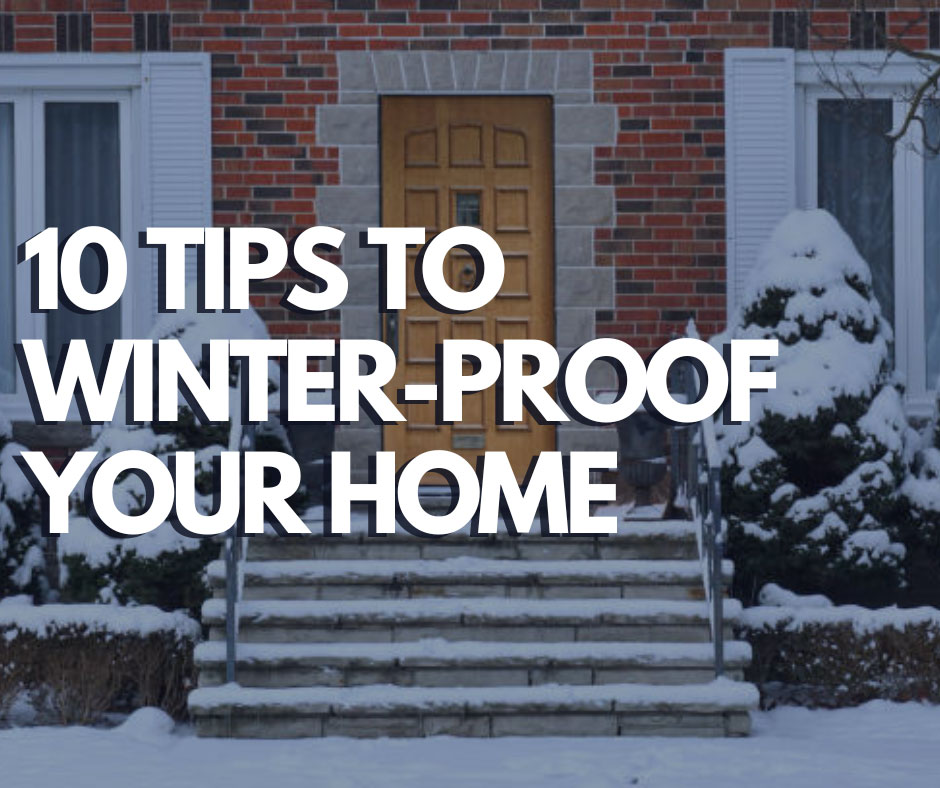Winter in Niagara can be unpredictable, marooned between two lakes, offering varying degrees of snow, ice, and rock-bottom temperatures. It’s crucial to ensure that your home remains a warm and welcoming haven during the chilly months.
Winter home maintenance is not only about comfort but also about safeguarding your property from the harsh elements.
Here’s 10 ways you can winter-proof your home!
Inspect and Clean Gutters:
Blocked gutters can lead to ice dams, causing water damage to your roof and interior. Before winter arrives, clear out debris from your gutters to ensure proper water flow. Install gutter guards to prevent leaves and other debris from clogging the gutters throughout the season.
Hacking away at ice dams with a hammer, chisel, or shovel is bad for your roofing—and dangerous for you. And throwing salt on them will do more to harm to your plantings than to the ice. Short of praying for warm weather, here are stop-gap measures we recommend.
Take a box fan into the attic and aim it at the underside of the roof where water is actively leaking in. This targeted dose of cold air will freeze the water in its tracks!
Check and Seal Windows and Doors:
Inspect windows and doors for any gaps or drafts. Use weatherstripping or caulk to seal any leaks, preventing cold air from entering and warm air from escaping. This not only enhances your home’s energy efficiency but also keeps your heating bills in check.
Window insulation kits are also a more affordable way to insulate multiple windows, and using heat control window film doesn’t interfere with the look of your windows.
Removable magnetic window insulation is also a cost-effective and seamless solution to drafty windows if you enjoy fresh air from time to time. For this option, replace the adhesive tape with magnetic tape on the plastic vinyl.
Service Your Heating System:
Schedule a professional inspection and maintenance service for your heating system. Clean or replace filters, check for any issues, and ensure that your furnace or heat pump is operating efficiently. A well-maintained heating system not only keeps you warm but also contributes to a healthier indoor environment.
Lowering the temperature of your home two to three degrees Celsius is optimal for saving energy and keeping your home comfortable. A good guide is to program 17°C when you are sleeping or not at home, and 20°C when you are awake and at home.
Keep it simple and install a smart thermostat so you can set it and forget it.
Protect Pipes from Freezing:
Frozen pipes can lead to costly damage. Insulate exposed pipes, especially those in unheated areas like the basement, attic, or crawl spaces. Know where your water shut-off valve is located in case of emergencies.
Let the cold water drip from a faucet served by exposed pipes, farthest from the main valve. Running water through the pipe—even at a trickle—helps prevent pipes from freezing.
Inspect Your Roof:
Check your roof for any missing or damaged shingles. Repairing these issues before winter storms hit can prevent leaks and water damage. Additionally, trim overhanging branches to prevent them from falling onto your roof during heavy snowfall or ice storms.
For asphalt shingles, insulation is the most critical component of roof protection in the winter. With the increasing ice and snow storms, it’s more important to ensure that your home is insulated effectively against potential snow loads and ice.
Melted snow is the number one cause of ice dams on roofs. Insulation must cover the home’s ceiling level effectively so the attic stays as cold as possible in the wintertime.
Maintain Your Fireplace and Chimney:
If you have a fireplace, ensure it’s in good working condition by having it inspected and cleaned. Creosote buildup can pose a fire hazard, so regular chimney maintenance is essential. Stock up on firewood early in the season, so you’re ready for cozy nights by the fire.
Whether you have a masonry or metal chimney, it is vital that you regularly check it for any cracks, dents, or rusts, as they could be signs of a bigger problem. Also, the chimney has a cap usually made of stone or metal slab, designed to keep water, birds, and other materials out. The cap features a screen on its side, which also functions as a spark arrester. Check the cap and the screen and replace them if necessary.
Winterize Your Outdoor Spaces:
Properly winterizing your outdoor spaces not only protects your investments but also makes springtime preparation much easier.
Ensure all downspouts are attached and clear of debris, clean and cover your grill, and drain and shut off exterior water sources.
Something else that you’ll want to do is get rid of dead tree limbs and cut back any foliage that’s making contact with your home.
It’s also important to cover outdoor furniture and drain water from fountains so they don’t freeze.
Test Smoke and Carbon Monoxide Detectors:
Winter often means increased use of heating appliances, so it’s crucial to ensure your smoke and carbon monoxide detectors are in working order. Test them regularly and replace batteries as needed to keep your family safe.
Replace CO detectors every five to seven years, and smoke detectors every 10 years. Install detectors on each level of your home, including the basement. The best places are in living rooms, where most fires start, and in or near bedrooms to wake you at night.
Prepare Your Lawn and Garden:
Trim back trees and shrubs to prevent damage from heavy snow and ice. Clean out gutters and downspouts to allow for proper drainage. Consider aerating and fertilizing your lawn in the fall to promote healthy growth come spring.
Some plants will naturally die back in the winter while others have to weather the cold if they want to survive to see next spring. You can help increase your plants’ odds of survival by covering them with old blankets or plastic sheeting when the temperatures drop below freezing.
Create an Emergency Kit:
Prepare for unexpected winter weather events by assembling an emergency kit. Include essentials such as flashlights, batteries, blankets, non-perishable food, and a first aid kit. Having these items readily available can provide peace of mind during storms or power outages.
Consider a Homem Power Generator, having some form of backup energy when the lights go out can be critical, especially for those in remote locations or with special medical needs.

